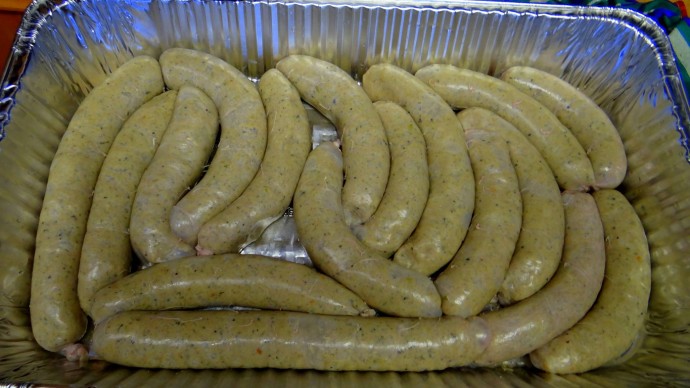My son and daughter-in-law are hosting Christmas this year and
Laurie decided she wanted to do a Cajun Christmas for a change. I
decided to make boudin sausage (pronounced bow-dan) and gumbo. I asked
her to come over to help me make boudin, a sausage I fell in love with
when Jim and I spent time in Cajun country in southern Louisiana. Our
first encounter was at Fred’s Lounge in Mamou, a tavern that is only
open on Sundays. We got there early, at 7:30 because there are very few
seats. The band starts about 9:00 and plays non-stop until five. The
band doesn’t take breaks, they are on radio while playing and one member
at a time gets up to have bite to eat or use the bathroom. A couple
came in with a paper bag of boudin and another of chitlins to share.
So, at 7:30 in the morning, we ate boudin for breakfast. Man, that stuff
is good.
In Calvin Trillin’s words:
In Calvin Trillin’s words:
“I figure that about 80 percent of the boudin purchased in Louisiana is consumed before the purchaser has left the parking lot, and most of the rest is polished off in the car. In other words, Cajun boudin not only doesn’t get outside the state; it usually doesn’t even get home.”
– Calvin Trillin, from his essay, “The Missing Links: In Praise of the Cajun Foodstuff That Doesn’t Get Around.”
I was given a cookbook, MaBee, What Ya Cooking? by
Janet Theriot in 2010. She had a recipe for boudin. Her cookbook is
homestyle cooking with not exactly precise measurements as in:
“One Boston butt pork roast or hogs head, salt , red and black pepper, 1
cup chopped parsley, 1 cup of chopped green onions and about 5 cups of
rice. Cut roast in big chuncks and cover with water and boil until
really tender.
I decided to look on-line and get more precise
directions and we came up with a recipe for 6 lbs of meat to 21 cups of
rice, basically three batches, with the onions and parsley and a number
of spices and went to work.
The first batch, we kept tasting and tasting. To heck
with the casings, Laurie, Ken, the boys and I, ate the first batch for
dinner with a salad. We put the steaks Ken was going to barbeque back in
the fridge. The stuff is scrumptious.
It is a job that dirties every dish in the cupboard, but
worth the work. We didn’t have a sausage stuffer and used a pastry tube
to load the casings by hand.
They are variable sizes and uneven looking, and we didn’t actually taste one of sausages since we ate the first batch.
I was a bit daunted by cooking 21 cups of rice, but it
is easy in a roasting pan in the oven and turned out just perfect. Now,
the rest of the story. Laurie ground both batches of meat and I put in
one batch of seven cups of rice. One of those easy miss-steps with two
cooks in the kitchen. I have no doubt it will taste good with half the
rice. It may be a bit spicier. I’ll let you know.
In the meantime, I wanted to find the origin of boudin so I looked it up on-line. Historian Bob Carriker puts it like this:
The French eat a sausage called “boudin blanc”
(white boudin) which is similar to Cajun boudin almost solely through
its nomenclature; for French boudin blanc is a highly perishable sausage
made with pork, chicken, and/or veal mixed with milk, cognac, and
spices. …its flavor bears no resemblance to the link you will sink your
teeth into in Louisiana. When the French Acadians (today’s Cajuns) made
their way out of Nova Scotia, after having been expelled by the British
in 1755, they adapted their traditions and culture to their new
surroundings. So, when they set out to make use of a freshly butchered
hog, it wouldn’t have been such a stretch for them to mix the pork
scraps with the seasonings at hand, push it into the hog’s intestines
and call it what they had always called such a sausage: boudin. . Later,
once large-scale rice production began in Louisiana at the end of the
nineteenth century, cooks added rice to boudin for filler and flavor.
Today in places like St. Martinville, at La Grande Boucherie des Cajuns
(a communal hog butchering) held the Sunday before Mardi Gras, the age
old practice of making boudin is embraced and the custom and community
spirit continues to be passed from one generation to the next.
I am so glad to have discovered this special treat and
thankful to have MaBee’s cookbook. I’ll be using her ettouffee recipe
and a real original called shrimp puppies. I can hardly wait. You can
read more about boudin and find out where to order boudin on this web
page.

No comments:
Post a Comment